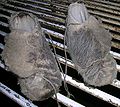
A moccasin is a shoe, made of deerskin or other soft leather, [1] consisting of a sole (made with leather that has not been "worked") and sides made of one piece of leather, [1] stitched together at the top, and sometimes with a vamp (additional panel of leather). The sole is soft and flexible and the upper part often is adorned with embroidery or beading. [1] Though sometimes worn inside, it is chiefly intended for outdoor use.
Contents
- History
- Contemporary use
- Driving moccasins
- Work boot moccasins
- Gallery
- See also
- References
- External links
Historically, it is the footwear of many indigenous people of North America; moreover, hunters, traders, and European settlers wore them. [1] Etymologically, moccasin derives from the Powhatan word makasin (cognate to Massachusett mohkisson / mokussin, Ojibwa makizin, Mi'kmaq mksɨn), [2] [3] and from the Proto-Algonquian word *maxkeseni (shoe). [4]







